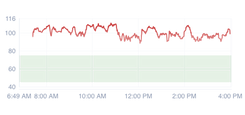Resting Respiratory Rate – Baseline, Recommended Value
Resting Respiration Rate
The Respiration Rate is another ‘Vital Sign’ which is most important for indicators of health in the human body. Respiration rate, reported in respirations(breaths) per minute. Each respiration has two phases: Inhalation and exhalation. During inhalation, oxygen is brought into the lungs from where it is transported throughout the body via the bloodstream, during exhalation the carbon dioxide is eliminated.
The resting respiration rate refers to the respiration rate when the person is relaxed. The speed of the respiration rate varies as a result of physical activity, threats to safety, and emotional responses.
A normal respiratory rate plays a critical role in keeping the balance of oxygen and carbon dioxide even. The normal respiration rate in adults is between 12 and 20 beats per minute as per NIH (National Institutes of Health, USA).
Resting Respiration Rate
What are healthy baselines
To actively monitor your health, you first need a healthy base for comparison, called a healthy baseline.
How are they updated
When you use Dozee for the first time, a generic baseline is set based on your age, BMI and gender. This baseline is used for the first week until Dozee has gathered enough data through at least four nights of sleep. Using this collected data, Dozee will create a new baseline specific to your body’s respiration rate.

Tachypnea (fast breathing)
Tachypnea is a medical term that refers to fast, shallow breathing. A lack of oxygen or too much of carbon dioxide in the body is a common cause. It can also result from other health issues as well. Tachypnea is not a disease, but a symptom that the body is trying to correct another problem.

Common causes of high respiration (Tachypnea) include:
- Anxiety: People may breathe faster when they are afraid or anxious. Fast breathing, or hyperventilation, is a common symptom of panic attacks. Fast breathing will usually pass once the anxiety goes away.
- Fever: As the body temperature increases with a fever, respiratory rate can also increase. The increase is the body’s way of trying to get rid of the heat.
- Respiratory diseases: Various lung diseases, such as asthma, pneumonia, and COPD, can make it difficult to breathe, which can lead to an increase in respiratory rate.
- Heart problems: If the heart does not pump properly to get oxygen to the organs, the body may react by breathing faster.
- Dehydration: Dehydration can increase breathing rate as the body tries to get the energy to the cells.
Risk Factors
Certain conditions can increase your risk of developing tachypnea:
- asthma
- pneumonia
- chronic obstructive pulmonary disease (COPD)
- pneumothorax, which is a collapsed lung
- A pulmonary embolism, which is a blood clot or blockage in a lung’s artery
- pulmonary fibrosis
- Cystic fibrosis
- Lung cancer
Bradypnea (slow breathing)
Bradypnea means that a person takes fewer breaths per minute than is usual for their age and activity level. When a person has a breathing rate of below 12 breaths per minute for more than 2 minutes, this suggests bradypnea. The average rate of breathing differs between individuals and can change depending on a person’s age and activity levels. Bradypnea can occur when a person is awake or asleep. It is different from apnea, which is a temporary halt in breathing that is most common when a person is sleeping. Bradypnea is also not the same as heavy or labored breathing, the medical term for which is dyspnea.
Causes
Bradypnea is a symptom rather than a condition in itself. It can signify an underlying physical problem or health condition, or it may indicate over-medication. There are many causes of bradypnea, which include:
- Exposure to drugs or toxins- Various drugs, including alcohol and opioids, can cause an abnormally slow rate of breathing. Bradypnea is one symptom of a drug overdose. Exposure to poisonous industrial chemicals or dangerous levels of carbon monoxide can also slow a person’s breathing rate.
- Surgery-Various medications that doctors use during surgery can cause bradypnea, including muscle relaxants, postoperative pain treatments, anesthetics.
- Hormonal imbalances-People with a condition called hypothyroidism have an underactive thyroid gland that may not produce enough hormones to keep the body’s metabolism at optimal levels. A slower breathing rate can develop as a result.
- Problems with the brain stem-The process of breathing begins in the brain. The respiratory centers in the lower brain stem and spinal cord send signals that stimulate the lungs, breathing muscles, and the rest of the body.
- Problems with the heart-Due to a connection between heart rhythm and breathing rates, anything that interferes with the function of the heart, such as heart failure or heart infection, can affect the activity of the respiratory system too.
Risk Factors
Slow breathing can result in low oxygen levels in the body. The most noticeable symptoms of bradypnea are similar to those of oxygen deprivation. Risk factors of bradypnea include:
- lightheadedness
- feeling faint
- dizziness
- chronic fatigue
- Headaches
- weakness
- confusion
- poor coordination
- chest pain
- memory problems




